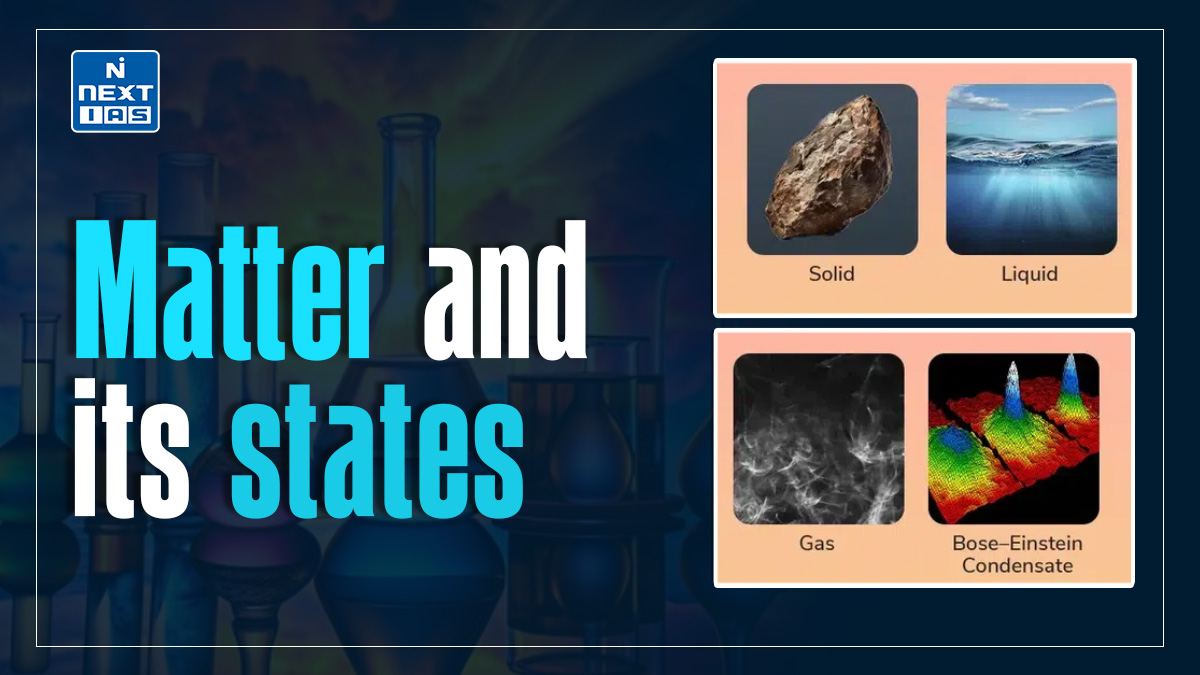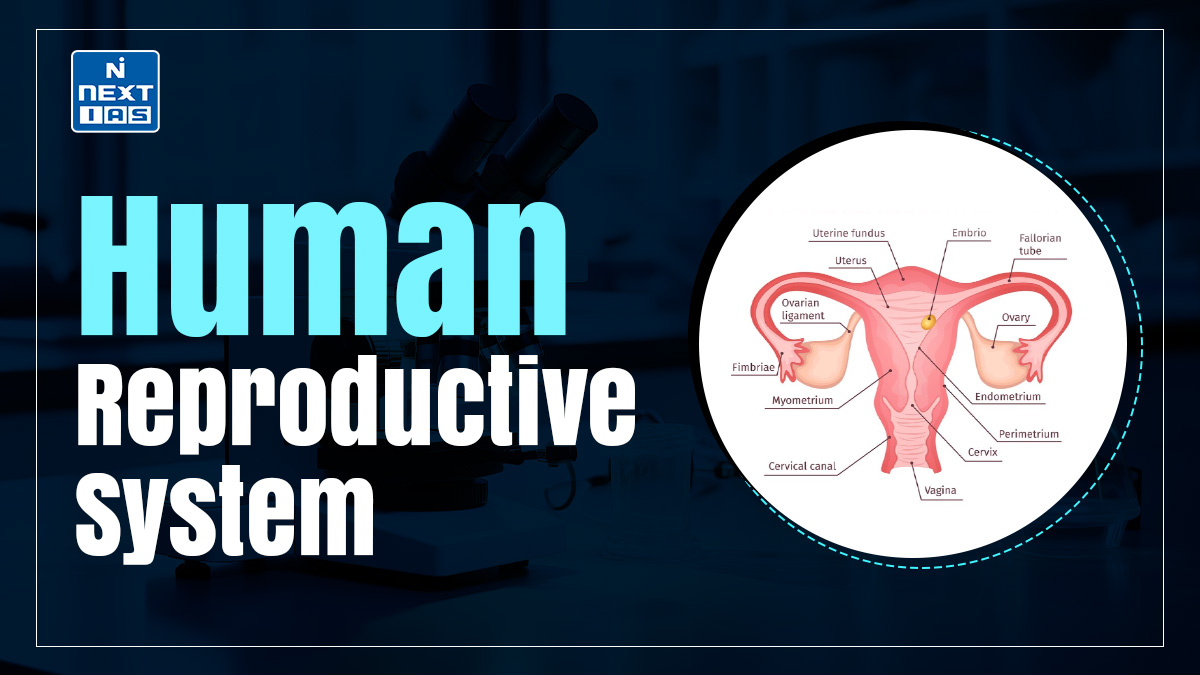
India’s nuclear research program, initiated in the 1940s, aims to develop peaceful nuclear technology for energy, agriculture, and medicine. Led by the Department of Atomic Energy (DAE), India has focused on self-reliance, achieving notable advancements in nuclear reactors, fuel cycle technology, and research into thorium-based reactors for sustainable energy.
About the India’s Nuclear Research Program
- India’s nuclear research program, initiated in the 1940s under the leadership of Dr. Homi J. Bhabha, has made significant strides in both energy production and technological advancements.
- The program is spearheaded by the Department of Atomic Energy (DAE), which operates the country’s nuclear power plants, research reactors, and develops nuclear technologies.
- India’s nuclear power capacity stands at approximately 6,780 MW, generated by 22 operational reactors across various plants, including the Kudankulam and Tarapur stations.
- India follows a three-stage nuclear program, focusing on utilizing its vast thorium reserves for long-term energy sustainability.
- India’s advanced reactor designs include Pressurized Heavy Water Reactors (PHWRs), Fast Breeder Reactors (FBRs), and the development of Small Modular Reactors (SMRs).
- The Prototype Fast Breeder Reactor (PFBR) in Tamil Nadu is a major step toward utilizing plutonium and thorium.
- Additionally, India has contributed to global nuclear science, conducting research in fields like radiation medicine, agriculture, and nuclear waste management.
- India has consciously proceeded to explore the possibility of tapping nuclear energy for the purpose of power generation and the Atomic Energy Act was framed and implemented with the set objectives of using two naturally occurring elements Uranium and Thorium having good potential to be utilized as nuclear fuel in Indian Nuclear Power Reactors. The estimated natural deposits of these elements in India are:
- Natural Uranium deposits – ~70,000 tonnes
- Thorium deposits – ~ 3,60,000 tonnes
Stages of Indian Nuclear Power Generation
STAGE 1: Pressurised Heavy Water Reactor
- It uses Natural UO2 as fuel matrix, Heavy water as moderator and coolant. Natural Uranium (U) isotopic composition is 0.7 % fissile U-235 and the rest is U-238.
- In the reactor, the first two plants were of boiling water reactors based on imported technology. Subsequent plants are of Pressurized Heavy Water Reactor (PHWR) type through indigenous R&D efforts. India achieved complete self- reliance in this technology and this stage of the programme is in the industrial domain.
Pressurised Heavy Water Reactor (PHWR)
- A pressurized heavy water reactor (PHWR) is a nuclear power reactor, commonly using unenriched natural uranium as its fuel, that uses heavy water (deuterium oxide D2O) as its coolant and moderator.
- The heavy water coolant is kept under pressure, allowing it to be heated to higher temperatures without boiling, much as in a typical pressurized water reactor. While heavy water is significantly more expensive than ordinary light water, it yields greatly enhanced neutron economy, allowing the reactor to operate without fuel enrichment facilities (mitigating the additional capital cost of the heavy water) and generally enhancing the ability of the reactor to efficiently make use of alternate fuel cycles.
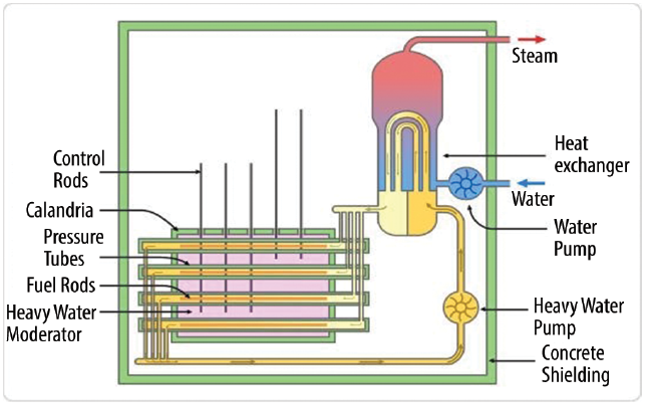
Future Plan
- Setting up of Water water Energetic Reactor (VVER) type plants based on Russian Technology is under progress to augment power generation.
- MOX fuel (Mixed oxide) is developed and introduced at Tarapur To conserve fuel and to develop new fuel technology.
Reprocessing of spent fuel is done by an Open Cycle or a Closed Cycle mode. “Open cycle” refers to disposal of the entire waste after subjecting to proper waste treatment. This Results in huge underutilization of the energy potential of Uranium (~ 2 % is exploited).
“Closed cycle” refers to chemical separation of U-238 and Pu-239 and further recycled while the other radioactive fission products were separated and sorted out according to their half-lives and activity and appropriately disposed of with minimum environmental disturbance.
- Both the options are in practice.
- As a part of long – term energy strategy, Japan and France has opted “closed cycle”
- India preferred a closed cycle mode in view of its phased expansion of nuclear power generation extending through the second and third stages.
- Indigenous technology for the reprocessing of the spent fuel as well as waste management programme has been developed by India through its own comprehensive R&D efforts and reprocessing plants were set up and are in operation thereby attaining self – reliance in this domain.
STAGE 2: Fast Breeder Reactor
- Indira Gandhi Centre for Atomic Research (IGCAR) has been carrying out a comprehensive R&D on sodium cooled fast breeder reactor technology for the past 30 years. A test reactor, called Fast Breeder Test Reactors (FBTR), is in operation since 1985, which has provided valuable feedback.
- Based on this experience and also taking into account the international experience, construction of a 500 MWe Prototype Fast Breeder Reactor (PFBR) is in the advanced stage.
- FBRs are designed with several safety measures and features which follow redundancy and diversity principles. Fast Breeder Reactors are safe and efficient apart from the benefits from environmental considerations.
- Economic viability of FBRs depends on successful operation of PFBR and subsequently successful commissioning and operation of FBRs in the country.
- The indigenously designed industrial scale prototype FBR of 500 MWe capacity is in an advanced stage of commissioning at Kalpakkam. Consenting process by Atomic Energy Regulatory Board (AERB) for the commissioning of PFBR has begun concurrently with the ongoing commissioning activities. It was scheduled to go critical in 2017.
- India’s second stage of nuclear power generation envisages the use of Pu-239 obtained from the first stage reactor operation, as the fuel core in fast breeder reactors (FBR). The main features of Fast Breeder Test Reactor (FBTR) are:
Pu-239 Serves as The Main Fissile Element in The FBR
- A blanket of U-238 surrounding the fuel core will undergo nuclear transmutation to produce fresh Pu-239 as more and more Pu-239 is consumed during the operation.
- Besides a blanket of Th-232 around the FBR core. Th-232 also undergoes neutron capture reactions leading to the formation of U-233. U-233 is the nuclear reactor fuel for the third stage of India’s Nuclear Power Programme.
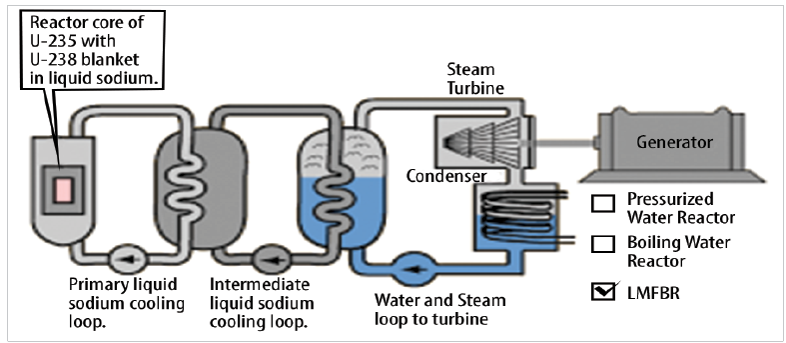
- It is technically feasible to produce sustained energy output of 420 GWe from FBR.
- Setting up Pu-239 fuelled fast Breeder Reactor of 500 MWe power generation is in advanced stage of completion. Concurrently, it is proposed to use thorium-based fuel, along with a small feed of plutonium-based fuel in Advanced Heavy Water Reactors (AHWRs).
- The AHWRs are expected to shorten the period of reaching the stage of large-scale thorium utilization.
Advantages
- Uranium deficient countries like India can use these for power generation as they produce more fuel than they consume. eg. Stage 2 of India’s nuclear programme is based on FBRs.
- Limitations Interest in fast breeder reactors has declined after the 1960s as more uranium reserves were found and new methods of uranium enrichment reduced fuel costs.
STAGE 3: Breeder Reactor
- The third phase of India’s Nuclear Power Generation programme is breeder reactors using U-233 fuel. India’s vast thorium deposits permit design and operation of U-233 fuelled breeder reactors.
- U-233 is obtained from the nuclear transmutation of Th-232 used as a blanket in the second phase Pu-239 fuelled FBR.
- Besides, U-233 fuelled breeder reactors will have a Th-232 blanket around the U-233 reactor core which will generate more U-233 as the reactor goes operational thus resulting in the production of more and more U-233 fuel from the Th-232 blanket as more of the U-233 in the fuel core is consumed helping to sustain the long term power generation fuel requirement.
- These U-233/Th-232 based breeder reactors are under development and would serve as the mainstay of the final thorium utilization stage of the Indian nuclear programme. The currently known Indian thorium reserves amount to 358,000 GWe-yr of electrical energy and can easily meet the energy requirements during the next century and beyond.
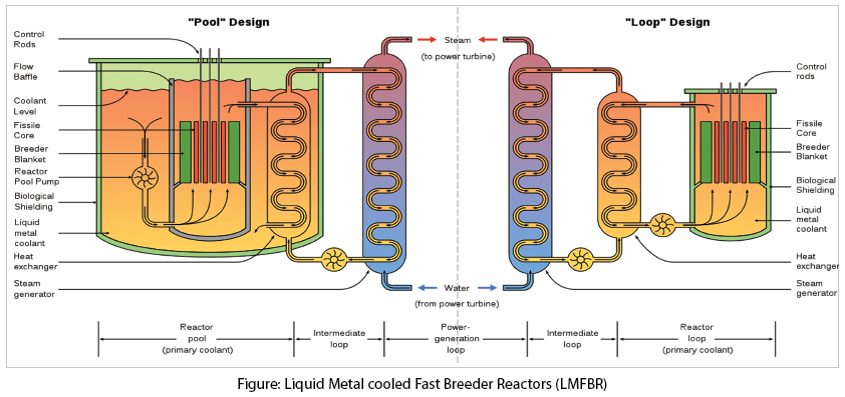
Advantages of India’s Nuclear Research Program
India’s nuclear research program offers several key advantages, contributing significantly to the country’s energy security, scientific development, and global position in nuclear technology. Some of the primary benefits include:
- Energy Security: India’s nuclear research program reduces dependence on imported fossil fuels, allowing for a more secure and stable energy supply. With the development of indigenous reactors, India can generate electricity while safeguarding its energy independence.
- Sustainable Energy: Through its three-stage nuclear program, including the focus on thorium, India is working toward a sustainable, long-term energy solution. Thorium-based reactors are expected to provide a safer and more efficient alternative to conventional uranium reactors.
- Technological Advancements: India has made significant strides in nuclear technology, particularly with Pressurized Heavy Water Reactors (PHWRs), Fast Breeder Reactors (FBRs), and the Prototype Fast Breeder Reactor (PFBR). These advancements position India as a leader in nuclear science and technology.
- Medical Applications: Nuclear research in India has contributed to advancements in radiation therapy for cancer treatment, as well as the development of medical isotopes used in diagnostic imaging, improving healthcare standards.
- Scientific and Research Contributions: India’s nuclear research program has strengthened its global reputation in nuclear science. Through collaborations with countries like the U.S., Russia, and France, India has contributed to global research on nuclear energy, safety, and waste management.
- Economic Benefits: The nuclear sector generates high-skill jobs, promotes local industry, and creates economic opportunities through the development of nuclear technologies and related infrastructure.
- Environmental Benefits: Nuclear energy generates low-carbon electricity, helping India meet its climate goals by reducing greenhouse gas emissions compared to fossil fuels, contributing to the country’s commitment to sustainable energy development.
India’s nuclear research program, thus, not only strengthens the nation’s energy capacity but also contributes to global advancements in nuclear science, healthcare, and environmental sustainability.
Way Forward
- The way forward for India’s nuclear research program involves expanding its nuclear power capacity with a focus on thorium-based reactors, enhancing fuel cycle technologies, and advancing Fast Breeder Reactors (FBRs) to ensure long-term energy sustainability.
- India also aims to develop Small Modular Reactors (SMRs) for safer and flexible power generation. Strengthening nuclear safety, waste management, and international collaborations will be crucial for achieving energy security while addressing climate change challenges. The program’s future emphasizes innovation, sustainability, and self-reliance in energy production.
Conclusion
India’s nuclear research program has made remarkable progress in energy, technology, and sustainability. By focusing on self-reliance and thorium-based reactors, India is poised to become a global leader in nuclear innovation, contributing significantly to clean energy solutions and advancing scientific research in various sectors.
GS - 3
